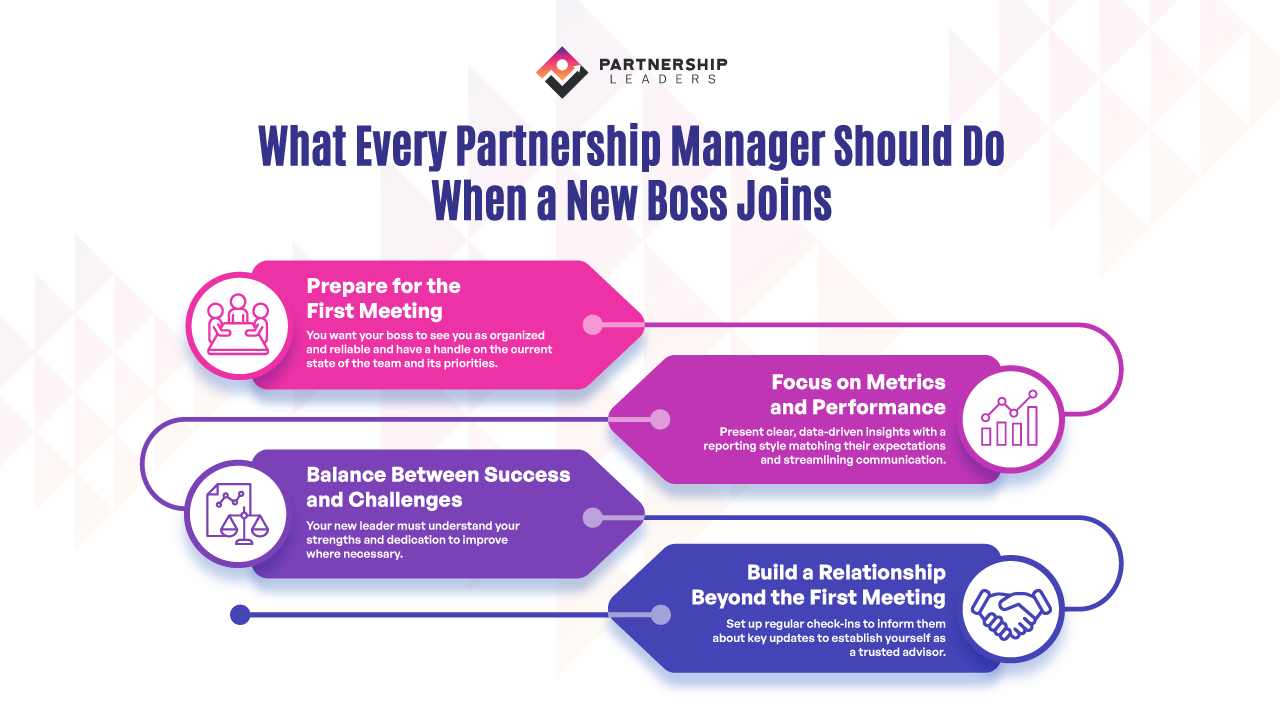When a new partnership leader joins your team, it can be both exciting and challenging. For partnership managers, the first meeting is a chance to set the tone and establish trust.
In this blog, we’ll explore how to approach your first meeting with a new boss so you’re seen as a valuable asset from day one.
Prepare for the First Meeting
When a new partnership leader joins, it’s crucial to come prepared and make a solid first impression. This could set the tone for how you’re perceived going forward. You want them to see you as someone who is organized, reliable, and has a handle on the current state of the team and its priorities.
“Make sure they leave thinking, ‘I don’t need to worry about this person – they’ve got it under control.” – Tai Rattigan
One way to ensure this impression sticks is by preparing a well-thought-out document before the meeting. This can include:
- Performance summary
- Partnership metrics
- Overview of your current projects
Offering to share this during the meeting or afterward shows you’re not only organized but also proactive and respectful of their time. This gives your new leader confidence that you take their role seriously and that they can trust you to stay on top of things.
Your document should highlight what’s going well and areas that could benefit from improvement. However, we suggest steering clear of complaints or finger-pointing.
“Complaining about anything – complainers are a problem for a new leader, not an asset.” – Tai Rattigan
Preparing for your meeting sets you apart as someone who’s focused on results, solutions, and collaboration, not just highlighting problems.
Focus on Metrics and Performance
Your new leader will be looking to understand how effectively your team is driving results. That’s why you must present clear, data-driven insights that the value you, as a partnership manager, bring to the organization.
As we said, gather relevant metrics that demonstrate the impact of the partnerships team, such as:
- Partner marketing efforts
- Revenue generated through sourcing versus influencing
- Percentage of successful partner deployments
The more specific and aligned with company goals, the better.
Don’t forget that how you present this information matters just as much as the data itself. Different leaders have different preferences, and it’s key to understand how they like reports to be structured.
“That first meeting is a great way for you to understand what information or data they care about and how best they like it to be displayed.” – Gabe Esuola
Adapting your reporting style to match their expectations will help streamline communication and build rapport early on.
Balance Between Success and Challenges
It’s tempting to focus solely on the positives when meeting a new leader or partnership manager, but don’t shy away from addressing challenges strategically.
New leaders often try to assess the situation, and offering successes and areas for improvement demonstrates your awareness and problem-solving mindset.
“I made a point to hit on what has been really successful and what I believe we should double down on, to balance between challenges and successes.” – Casey Padgett
A good way to approach this balance is to start with the wins.
Lead the conversation with what’s working:
- Partner marketing campaigns that have taken off
- Successful partner onboarding processes
- Standout revenue from sourced partnerships.
These are the achievements that showcase your team’s effectiveness and your leadership in driving these initiatives.
However, when it comes to challenges, frame them as opportunities for growth. For example, if a particular area of the partnership strategy isn’t performing as well, talk about potential solutions instead of focusing on the shortcomings.
Striking a balance between showcasing successes and discussing challenges constructively leaves your new leader with a clear understanding of your strengths as a partnership manager and your dedication to improving where necessary.
Build a Relationship Beyond the First Meeting
The first meeting with a new leader is just the beginning. Beyond sharing data and discussing performance, focus on finding common ground and establishing a rapport that goes beyond the numbers.
“Understand where you share some commonality around interests or passions and build on that while exemplifying your rock star status.” – Gabe Esuola
Whether it’s shared professional goals, a common vision for the partnership strategy, or even personal interests, these touchpoints can create a solid foundation of trust and open communication.
As a partnership manager, you should take note of their preferences early on and adjust your communication style accordingly. This includes things like:
- Report formats
- Cadence of updates
- Depth of detail
Don’t underestimate the value of ongoing dialogue as well.
Set up regular check-ins to keep them informed about key updates and to continue building the relationship. Over time, these interactions will help you establish yourself as a trusted advisor, someone they can rely on not only for execution but for strategic guidance as well.
As a partnership manager, your ability to connect professionally and personally can have a lasting impact on your team’s success and your leader’s confidence in you.
Conclusion
Meeting a new partnership leader allows any partnership manager to showcase their strengths and set the tone for a successful working relationship. Approach the transition with professionalism, flexibility, and openness, and you’ll build a foundation for long-term collaboration and mutual success with your new leader.
Join The 1850+ Leaders Transforming Partnerships
As a member of Partnership Leaders, you will:
- Build and learn with the top partner people at the best companies around the world.
- Increase your impact and accelerate your career with proven resources, tools, and best practices.
- Grow a network of peers, partners, and advisors with common objectives.


